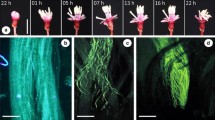Abstract
The floral biology and breeding system of Alpinia blepharocalyx were studied in Yunnan province, southwest China. Our results indicate that populations of A. blepharocalyx have two floral morphs, which differ in flowering behaviour: the cataflexistylous morph in which the stigma is held erect above the dehiscent anther when anthesis begins in the morning and becomes curved under the anther at afternoon, and the anaflexistylous morph in which the receptive stigma is curved under the indehiscent anther first and moves into a reflexed superior position above the anther as it begins to shed pollen in the afternoon; the flowering period of both floral morphs is 12 hours; the stylar movements in the two floral morphs are synchronous, and they have similar traits to those found in other Alpinia species previously reported. Also, on average, cataflexistylous flowers are larger than anaflexistylous flowers, especially the labellum and corolla tube length; moreover, the P/O ratio of the two floral morphs is significantly different: the cataflexistylous morph has more pollen grains and fewer ovules than the anaflexistylous morph; the evolutionary significance of this comparison is discussed. Cataflexistylous flowers were observed to produce a lower concentration of nectar than that of anaflexistylous flowers before 11:00 a.m., but they then have higher nectar concentration; cataflexistylous flowers always have more nectar than anaflexistylous flowers. Flowers of A. blepharocalyx were visited by fewer insects at a lower frequency, including honey bees (Apis cerana cerana) and two species of carpenter bees (Xylocopa spp.). No significant differences were found in the fruit set among the hand-pollination treatments regardless of selfing (geitonogamy and autogamy) or crossing (intermorph and intramorph); but all hand-pollination treatments exhibited much higher fruit set than the controls; meanwhile, no fruit set occurred in the unpollinated bagged plants. Pollen tube growth was examined using fluorescence microscopy following self, intramorph, and intermorph hand pollinations at different times of the day; the pollen tubes of both floral morphs have the same growth rate and the capability to reach the ovary. Both the results of pollen tube growth and fruit sets under different pollination conditions show that A. blepharocalyx is self-compatible and dependent upon insects for pollination. The distinctive flexistyly mechanism of A. blepharocalyx is likely a floral mechanism that promotes effective intermorph pollen transfer.
Similar content being viewed by others
Author information
Authors and Affiliations
Corresponding author
Rights and permissions
About this article
Cite this article
Zhang, L., Li, QJ., Deng, XB. et al. Reproductive biology of Alpinia blepharocalyx (Zingiberaceae): another example of flexistyly. Plant Syst. Evol. 241, 67–76 (2003). https://doi.org/10.1007/s00606-003-0021-2
Received:
Published:
Issue Date:
DOI: https://doi.org/10.1007/s00606-003-0021-2




